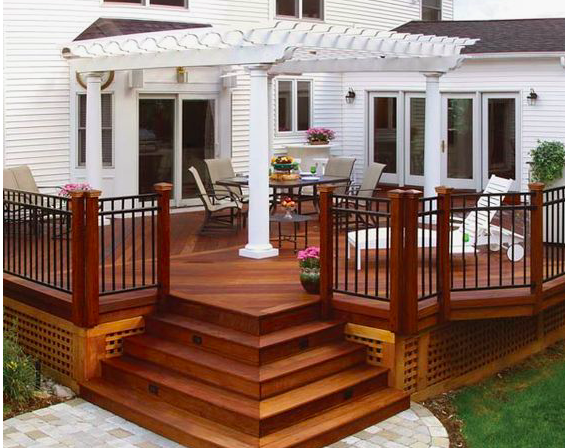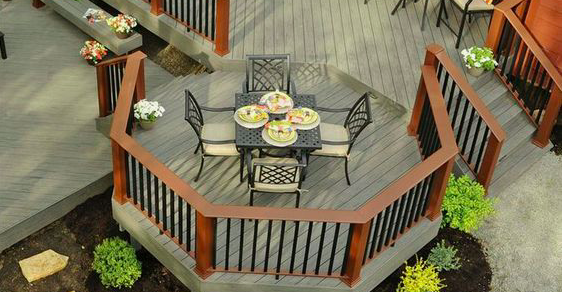HOW TO PROPERLY SPRING CLEAN YOUR DECK
May 13th, 2019 | by James BaldwinIt’s safe to say that most people treasure their decks and outdoor living spaces. Just like anything we cherish though, we must take care of these things in order for them to last. Decks and outdoor living spaces fall into a category of home improvements that tend to be overlooked when it comes to maintenance.

There are a number of reasons why homeowners often fall short in their deck upkeep responsibilities, one of the most common being an understandable reluctance to spend money on a tight budget. If the deck sees little activity over the course of the year, it’s easy for people to convince themselves that no maintenance action is necessary. This is a very serious misconception though.
WHAT CAN CAUSE DAMAGE TO YOUR DECK?
Even when you’re not using your deck, it’s still vulnerable to damaging hazards. UV rays from the sun are an underestimated menace, causing premature aging to your deck boards. Particularly, if your deck boards have not been treated with an adequate sealer.

If you live in a freeze-thaw region, meaning that the temperatures outside range from below freezing to well above freezing in a singular year, this is something that can take a major toll on your deck boards. The cold weather over the course of the year causes boards to expand and contract. This will gradually enlarge cracks in the wood.
Rain and snow can cause the formation of moisture pockets on your deck, which in turn invites wood-destroying mold and termites. Moisture promotes rust on nails and screws as well.
If your deck is somewhere that leaves and small fallen branches tend to gather, this also can cause a great deal of moisture build-up over time. This can cause mold and at times rust, depending upon the materials that were used to construct your deck.
Ignorance of any of the above issues can cause large problems in the long run if left unattended. Keep up with your deck. This is an extension of your home and can add great value to your home if kept up with throughout the years.
STEPS TO FOLLOW WHEN SPRING CLEANING YOUR DECK
We all live busy lives and it can be burdensome to try to set aside time to spend cleaning your deck and maintaining it. However, this is completely necessary if you want you outdoor living area to be kept safe and standing for many years to come

Once springtime hits, most of us have cleaning on our minds. The addition of a few hours spent cleaning and maintaining your outdoor deck area can save you money in the long run. Below is a simple list of spring maintenance tips that should be followed to keep your deck in tip-top shape!
1. Remove debris from between deck boards using a putty knife. Pay special attention to the areas where deck boards cross the joists — the structural members underneath the decking.
2. Thoroughly sweep the deck.
3. Choose an appropriate cleanser:
- Wood deck: Use a standard deck cleaner and follow its directions. Some require the decking to be wet first. Some don’t.
- Composite deck: Use a cleaner specifically formulated for composite material. Attack grease and oil stains with a commercial degreaser and detergents.
4. Clean the deck. Choose a cloudy day when the decking is cool and the sun won’t evaporate the cleaner.
- Wood deck: Use a paint roller, a garden sprayer, or a stiff-bristled brush broom to apply the cleaner. Don’t let it pool. Don’t let the deck dry until you’ve scrubbed it clean. Then let it soak according to manufacturer’s instructions (usually about 10 minutes). Rinse thoroughly with clean water.
- Composite deck: Scrub with a soft brush. Do not use a pressure washer — it can permanently damage the decking and will void any warranty. Remove rust and leaf stains with a few drops of dish-soap in warm water. Make sure you rinse well. If you begin seeing a chalky residue being left behind, you simply need to continue to rinse the deck until all detergents that were used are fully washed away.
5. When the weather is warm and dry, it’s a good time to give your deck’s structure a close inspection. This goes for any type of deck, wood or composite. Here are some things to look for:
- Look for signs of rot. Begin by checking stairs, Also check each perimeter post. If you can push the screwdriver a quarter-inch or more into a suspect area, you probably have rot.
- Inspect the ledger. Using a flashlight underneath your deck, pay special attention to the ledger — the piece of framing that attaches the deck to the house. A damaged ledger is the cause of 90% of all deck collapses.
- Check remaining joists, posts, and beams. Check all the hardware underneath, especially joist hangers, and replace any that are seriously rusted. Probe for signs of rot on the posts and joists.
- Check for cracks or rotten decking boards. Not all cracks are a structural threat, but they’ll get worse with time.
- Check the railing. Give it a good shake to be sure posts are not loose or damaged. Look for cracks that, over time, may have developed around fasteners such as nails or screws.
As you can see the difference between maintains a natural wood deck and a composite deck are very different. This is why at SelectDecks our focus is exclusively on composition decking. We believe that composite decks and outside living areas give our customers the greatest value out of their money and require the least amount of hard maintenance work after installed.